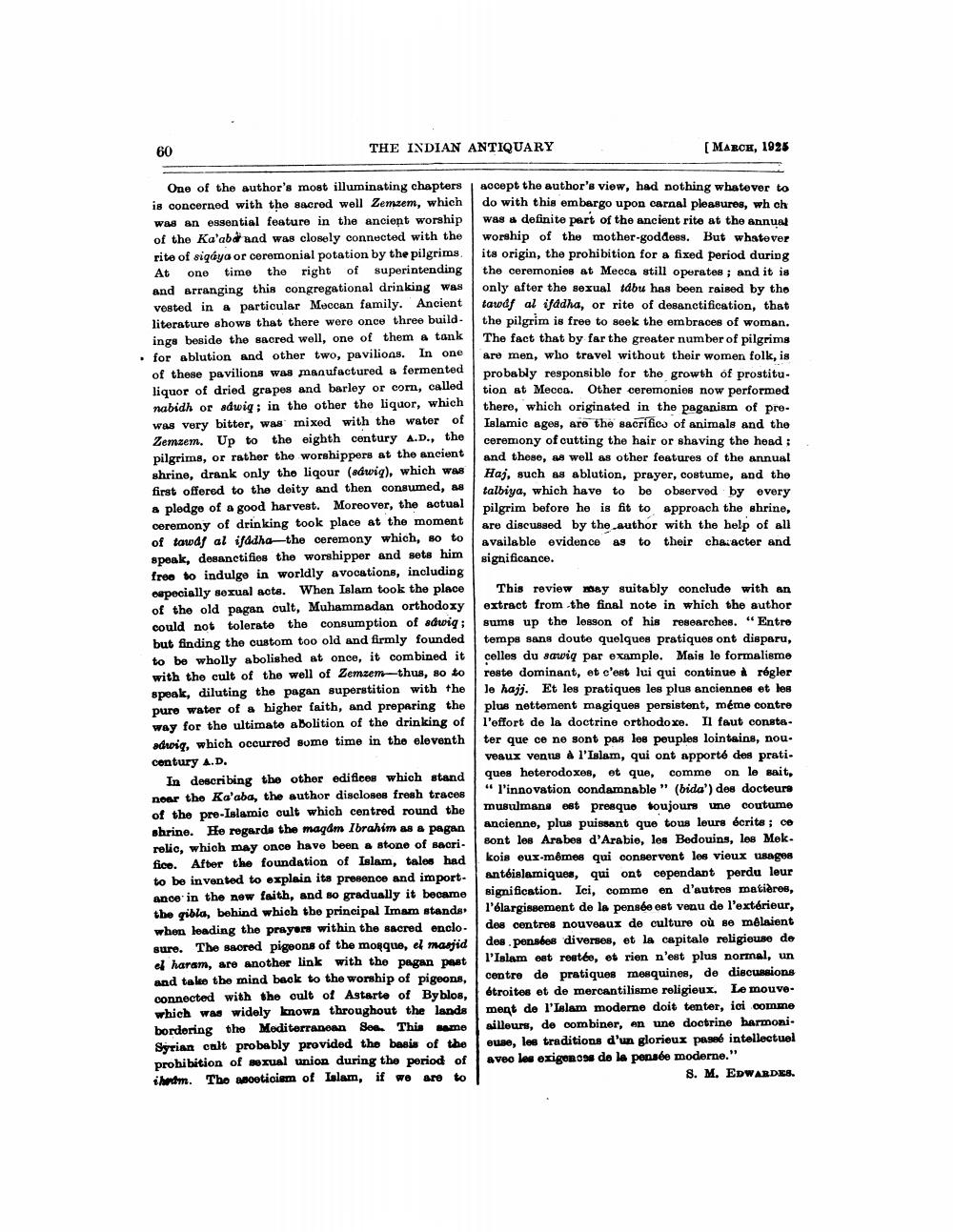________________
60
THE INDIAN ANTIQUARY
[MARCH, 1925
accept the author's view, had nothing whatever to do with this embargo upon carnal pleasures, wh ch was a definite part of the ancient rite at the annual worship of the mother-goddess. But whatever its origin, the prohibition for a fixed period during the ceremonies at Mecca still operates; and it is only after the sexual idbu has been raised by the tawdy al ifadha, or rite of desanctification, that the pilgrim is free to seek the embraces of woman. The fact that by far the greater number of pilgrims are men, who travel without their women folk, is probably responsible for the growth of prostitution at Mecce. Other ceremonies now performed there, which originated in the paganism of preIslamic ages, are the sacrifica of animals and the ceremony of cutting the hair or shaving the head : and those, as well as other features of the annual Haj, such as ablution, prayer, costume, and the talbiya, which have to be observed by every pilgrim before he is fit to approach the shrine, are discussed by the author with the help of all available evidence 49 to their cha acter and significance.
One of the author's most illuminating chapters is concerned with the sacred well Zemzem, which was an essential feature in the ancient worship of the Ka'abat and was closely connected with the rito of siqaya or ceremonial potation by the pilgrims At one time the right of superintending and arranging this congregational drinking was vested in a particular Moccan family. Ancient literature shows that there were once three build
inge beside the sacred well, one of them a tank . for ablution and other two, pavilions. In one
of these pavilions was manufactured a fermented liquor of dried grapes and barley or com, called nabidh or adwig: in the other the liquor, which was very bitter, was mixed with the water of Zemzem. Up to the eighth century A.D., the pilgrims, or rather the worshippers at the ancient shrine, drank only the liqour (adwig), which was first offered to the deity and then consumed, as a pledge of a good harvest. Moreover, the actual ceremony of drinking took place at the moment of tawdy al ifadha—the ceremony which, so to speak, desanctifies the worshipper and sets him free to indulge in worldly avocations, including especially sexual acts. When Islam took the place of the old pagan cult, Muhammadan orthodoxy could not tolerate the consumption of sdwig: but finding the custom too old and firmly founded to be wholly abolished at once, it combined it with the cult of the well of Zemzem—thus, so to speak, diluting the pagan superstition with the pure water of a higher faith, and preparing the way for the ultimato abolition of the drinking of adwig, which occurred some time in the eleventh century A.D.
In describing the other edifices which stand noar the Ka'aba, the author discloses fresh traces of the pre-Islamic cult which centred round the shrine. He regarde the maqdim Ibrahim as a pagan relio, which may once have been a stone of sacri fice. After the foundation of Islam, tales had to be invented to explain its presence and importance in the new faith, and so gradually it became the qibla, behind which the principal Imam stands when leading the prayers within the sacred onclo. sure. The sacred pigeons of the moque, el masjid el haram, are another link with the pagan past and take the mind back to the worship of pigeons, connected with the cult of Astarte of Byblos, which was widely known throughout the lands bordoring the Mediterranean Sos. This same Syrian cult probably provided the basis of the prohibition of sexual union during the period of ihnim. The aceticism of Islam, if we are to
This review may suitably conclude with an extract from the final note in which the author sums up the lesson of his researches. "Entre temps sans doute quelques pratiques ont disparu, celles du sawig par example. Mais le formalisme reste dominant, et c'est lui qui continue à régler le haji. Et les pratiques les plus anciennes et les plus nettement magiques persistent, méme contro l'effort de la doctrine orthodoxe. Il faut consta ter que ce ne sont pas les peuples lointains, nou. veaux venus à l'Islam, qui ont apporté des prati. ques heterodoxes, et que, comme on le sait, " l'innovation condamnable" (bida') des docteurs musulmans est presque toujours me coutume ancienne, plus puissant que tous leurs écrits ; co Bont les Arabes d'Arabie, les Bedouins, les Mek. kois eux-mêmes qui conservent les vieux usages antóislamiques, qui ont cependant perdu leur signification. Ici, comme en d'autres matières, l'élargissement de la pensée est venu de l'extérieur, des centres nouveaux de culture où se mêlaient des pensées diverses, et la capitale religieuse de l'Islam est restée, et rien n'est plus normal, un centre de pratiques mesquines, de discussions étroites et de mercantilisme religieux. Le mouvement de l'Islam moderne doit tenter, ici comme ailleurs, de combiner, en une doctrine harmoni.
use, les traditions d'un glorieux paseé intellectuel avec les exige 09 de la pensée moderne."
S. M. EDWARDES.




